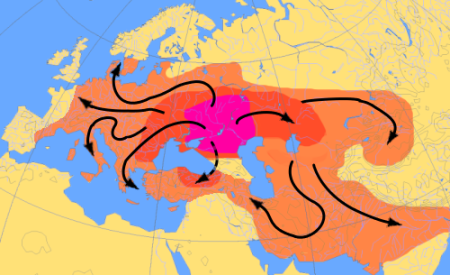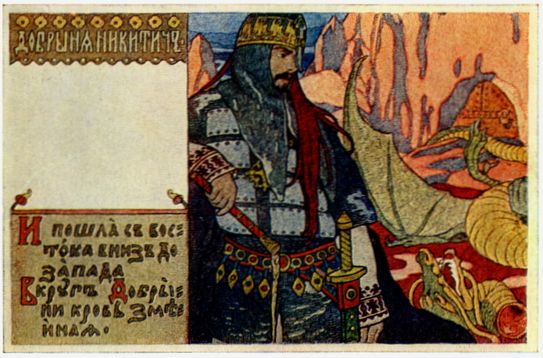Way, way back…
According to what we understand of the weapons, tools, and other items they left behind, the ancient people who spoke the language that we know today as Proto-Indo-European (PIE) probably came from the grassland steppe between the Black Sea and the Caspian Sea, sometime in the early Bronze Age (ca. 3400 BC). This steppe covers a wide area of what is now far Eastern Europe—western Ukraine, Moldova, southern Russia, and into Kazakhstan—so the precise location of their origin is uncertain. But the best theory going is that they were a pastoral people who raised various kinds of crops, and who had also domesticated the dog, the horse, and the cow. Because of the importance of agriculture in the religions and daily lives of the cultures descended from the speakers of PIE, we can confidently project these practices backward to the time of PIE itself [1].
The domestication of the horse gave the ancient PIE culture the potential to be mobile, and the ability to spread out and establish new homes in far-flung places. This is probably the way in which the PIE culture spread from its homeland—especially once the people encountered the technology of the chariot—into Central and Southern Asia, Asia Minor (Turkey), and into Europe. As they spread, they took their culture with them, and it evolved over the centuries into the cultures of modern day India, Europe, and Iran. In addition to a common inheritance of words, these cultures share a common inheritance of ideas. Each culture developed its own unique expression of this inheritance, but traces of the original PIE foundation lived on in the legends and stories of the Indo-European cultures.

The Oral-Formulaic Poem
Even the methods of storytelling were a legacy of PIE culture, and most of the “daughter cultures” tend to share significant features in their formal poetry. We know from ancient written sources—many of which preserve even older spoken sources—that the Latin, Greek, Persian, and Indian cultures had formal poetry that was intended to be spoken, sung, or otherwise performed. The use of formulaic language—that is, fixed words or groups of words that served to fill out lines of verse according to a pattern of meter [1].
But what is meter? The word itself comes from the Greek term for ‘measure.’ There are different types of poetic meter, depending on what is being measured in a given line of poetry. It can be the number of syllables in the line, or it can be the number of accented syllables in a line—it can even be the weight of syllables in the line relative to each other. This just means that some syllables are counted as light (or short), and some are counted as heavy (or long) [2]. Most of the oldest recorded poetry in the Indo- European family is done in this way—from the Rig Veda of India, to the Ancient Greek poems of Homer and the Aeneid of Virgil. The process of using poetic fomulas (or formulae) would allow ancient poets—who largely had neither the ability nor the inclination to read or write down their work—to more easily memorize lengthy myths, stories, and the histories of noble families. Formulas would also have allowed poets to improvise new forms of any given story on the spot with a ready supply of convenient stock phrases or words to finish out the line (often accompanied by music).
The bylina
Back in the “heartland” of the old PIE territory, the Slavic-speaking peoples had developed a considerable oral epic tradition in keeping with their ancient cultural roots. The name of the genre of Russian and Ukrainian oral-formulaic folk poetry comes from the Russian verb byt’, which means ‘to be.’ The past form of this is byl, and so a bylina (plural byliny) is literally a song of ‘something that was.’ The term is often translated and categorized as a kind of oral folk ‘history’ [3]. However, it would be wrong to think of byliny as histories in the sense that we usually use the word in English—it’s more like the way the ancient Greeks and Romans thought of their own myths and legends as ‘history.’ The stories are conditioned by society in order to reinforce certain values, and to provide the community with a sense of self and place in the world [4].
Byliny reflect many of the themes inherited in common by the Indo-European cultures [4]. In particular, the songs of the dragon-slaying hero Dobrynya Nikitich [3] parallel many of the features found in the myths of India, Scandinavia, and the Mediterranean. Many of the oldest epics and folktales—such as the tale of Ilya Muromets and the Falconer—also involve animals with magical abilities [5]. The particular animals are almost always foxes, bears, and other woodland creatures whose original PIE names had become taboo in some descendant cultures possibly because of their association with magic or the supernatural [1].

Like the oral poetry and songs of Homer in 600 BC Greece, the byliny of Russia and Ukraine represented the labor of generations of bards from different parts of eastern Russia. Each poet drew on a repertory of inherited and memorized formulaic poetic language, but in performance the bard would insert material of his own divising, adapting the formulas and tailoring them for a specific setting or audience. As is usually the case with oral-formulaic poetry, byliny were mostly performed to musical accompaniment [6]. Even more impressively, the performers were usually men who had been born blind, or who had lost their eyesight in early childhood. Unable to participate in the strenuous chores of daily peasant farming life in which every spare hand was needed, these young men were often apprenticed to traveling bards. These bards—who were usually blind as well, of course—would instruct their apprentices in the art of oral formulas and meter and rhythm. In this way, these severely handicapped young men could become renowned singers and preservers of a rich cultural heritage [3].
The peoples of rural Ukraine and Russia are bearers of a rich and ancient cultural legacy. Although not many professional singers still exist, the byliny are kept alive by amateur enthusiasts, scholars, and in rural folk stories. These songs, stories, and poems directly reflect age-old forms and symbols that resonate throughout Indo-European culture, and provide a window into the past for those who can appreciate them.
Chris Taylor, 4/28/2014
Lexington, Kentucky
For Further Reading:
- Bailey, James, Tatyana Ivanova, and Tatyana Avanova. 1998. An Anthology of Russian Folk Epics. ME Sharpe.
- Fortson, Benjamin W. 2010. Indo-European Language and Culture: an Introduction (2nd ed.). Blackwell.
- Fussell, Paul. 1979. Poetic Meter & Poetic Form (2nd ed.). McGraw-Hill College.
- Haney, Jack V. 2009. An Anthology of Russian Songs and Folktales. ME Sharpe.
- Kononenko, Natalie. 1998. Ukrainian Minstrels: And the Blind Shall Sing. ME Sharpe.
- Propp, Vladimir Yakovlevich. 1958. The Russian Heroic Epic. Moscow.
- Reeder, Roberta. 1993. Russian Folk Lyrics. Indiana University Press.

Pingback: 記事更新